Minolta and Auto Minolta
The Minolta (ミノルタ) and the Autofocus Minolta (オートフォーカスミノルタ) or Auto Minolta (オートミノルタ) are strut-folding cameras taking 6.5×9cm plates or film sheets, made by Molta and later Chiyoda Kōgaku Seikō (predecessors of the Minolta company).
Contents
Description

|
| Molta's MTS logo. (Image rights) |
The Minolta and Auto Minolta were much inspired by the Plaubel Makina, but have a reversed configuration, with the viewfinder on the photographer's left.
The rectangular front plate is mounted on scissor struts. The spring-loaded main struts, at the top and bottom, are attached to a shaft on the right. They are complemented by smaller struts on the left-hand side. The camera is opened by a small button placed on the left-hand side of the body. There is a leather handle on the photographer's right, a metal handle on the left, and two tripod threads (at the bottom and on the left).
The viewfinder consists of a glass element at the front, retractable in a small spring-loaded casing attached to the front plate, and an eyepiece hinged to the main body, at the rear. It does not provide parallax correction, unlike that of the Plaubel Makina.
 
|
| Crown A shutter, locked and unlocked. Pictures by A. Apra. (Image rights) |

|
| Distance dial. (Image rights) |
The camera is focused by turning a small knob at the right end of the front plate, which controls the angle of the main struts. The distance is indicated by an index rotating inside a circular scale, under the viewfinder casing. The index is always pointing at three o'clock when the distance is set to infinity; minor variations are known in the minimum distance (1m or 1.1m), and in the position of the index at minimum distance (12 o'clock or 10 o'clock). There is a button placed between the lens and the focusing wheel, unlocking the scissor struts to close the camera.
The lens is fixed, unlike that of the Plaubel Makina, and always has f/4.5 aperture and 105mm (or 10.5cm) focal length. The shutter is either a Lidex or Crown made by the Molta company itself, or an imported Compur. Both Japanese shutters are everset, and have a button on the side used as a release lock, blocking the travel of the release lever when pushed, and disengaged when pulled.[1]
The name Minolta and the body serial number are engraved on the viewfinder's front casing, and the round MTS logo of the Molta company is embossed at the top of the front plate, above the opening button.
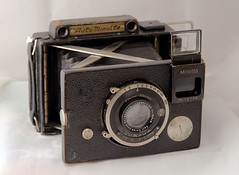  
|
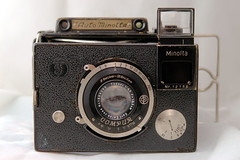  
|
| Auto Minolta no.12186, Compur shutter (T, B, 1–250), Carl Zeiss Tessar 10.5cm f/4.5 lens no.1859293. Pictures courtesy of S. Montagna. (Image rights) |
Original Minolta
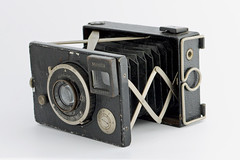 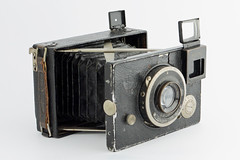 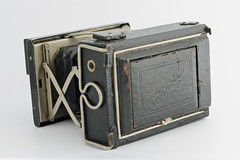
|
| Minolta no.12266, Crown shutter (T, B, 1–200), Actiplan Anastigmat Nippon 1:4.5 f=105mm Nr101293. Pictures by Fragarach (Image rights) |
The original Minolta[2] (ミノルタ) has no rangefinder. It always focuses down to 1m, with the close distance setting at 12 o'clock on the circular scale. It was initially released with a Lidex shutter, later substituted by a Crown; at least one example is also known with a rim-set Compur which is perhaps original. The early examples have an Actiplan Anastigmat München 105mm f/4.5 lens, whose origin is unclear (see the corresponding page). The late examples perhaps have an Actiplan Anastigmat Nippon 105mm f/4.5, said to have been supplied by Asahi Kōgaku (predecessor of Pentax), but this is unconfirmed.[3]
Release date and original documents
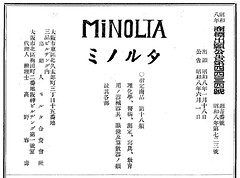
|
| Registration of the Minolta trademark (1933). Downloaded from the IPDL, in accordance to the IPDL policies. |
This model was certainly the first camera to use the name "Minolta".[4] The release date is given as 1933 in early historical accounts by the Minolta company or its predecessors, including a chronology published in 1958 and the fifty-year history book (1978) — the latter specifies June.[5] This release year is repeated in many later sources, but some say 1934 instead.[6] The year 1933 is made plausible by the date of registration of the "Minolta" trademark, which was applied for on Jan. 18, 1933, published on June 1st and finally registered on Sep. 20.[7]
 
|
| Leaflet for the original Minolta, dating c.1933–4. Scans by A. Apra. (Image rights) |
The original Minolta appears as the "Minolta Camera" (ミノルタ・カメラ) in an early leaflet by Asanuma Shōkai.[8] The price is given as ¥97, including a lens and shutter cap, six plate holders, a film pack holder and a soft release. A "special bag for the Minolta camera" (特製ミノルタ用鞄) is offered for ¥4 extra. The pictured camera has no visible serial number, certainly because the picture was retouched. Its viewfinder eyepiece has a rounded top, and its shutter is an everset Lidex (T, B, 1–200). The shutter plate has the words Patents(J.N.)–Pending at the top. The lens marking is faintly legible as Actiplan Anastigmat München, with no.7770x. The document mentions the shutter lock, called "safety device" (安全装置). It also says that the aperture is set to f/25 when the lens cap is removed; this presumably means that the aperture lever must be manually set to f/25 to fit the cap.
 
|
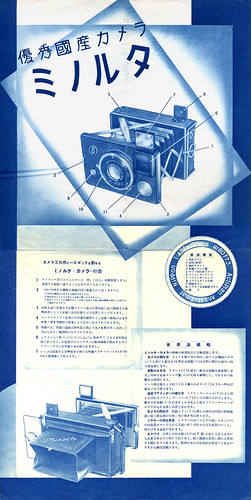
|

| |
| Leaflet for the original Minolta, dating c.1934–5. Scans by A. Apra. (Image rights) | |
Another leaflet, certainly published a little later, features the actress Tanaka Kinuyo (田中絹代) holding the camera.[9] The text gives the same information and price as above, but says that the shutter is a Crown (T, B, 1–200), again with a "safety device".
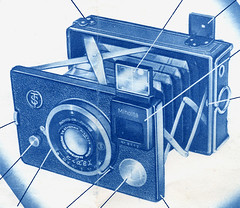 
|
| Minolta no.9112, Lidex shutter, Actiplan Anastigmat München 105mm f/4.5 no.80773. Scans by A. Apra. (Image rights) |
In the document, at least two cameras are pictured; both have a rectangular instead of rounded eyepiece. The earlier has body no.9112, a Lidex shutter, and the Actiplan Anastigmat München lens no.80773. (A schematic drawing of the same lens no.80773 reads Actiplan Anastigmat Nippon instead, for commercial purpose.) The shutter is marked Patents(J.N.)–Pending at the top, and a plate inscribed PATENT PENDING is attached to the rear of the front standard, where later Auto Minolta have PATENTS–NIPPON (see below). The other camera, with body no.9454, has a Crown shutter, but fewer details are visible.

|
| Original Minolta, in a leaflet for the Minolta and Happy range dating c.1935. The Crown marking is the result of a retouch. Scan by A. Apra. (Image rights) |
A leaflet for the Minolta and Happy range, dating c.1935, after the release of the rangefinder Auto Minolta, offers the viewfinder-only Minolta at the same price of ¥97 with an Actiplan f/4.5 and a Crown (1–200).[10] One of the pictures of the first leaflet was re-used after further retouch, replacing the Lidex shutter marking by a non-standard Crown marking. (This picture of a camera with rounded eyepiece was certainly outdated at the time.) The retouched picture was reproduced in many later sources, sometimes in a cropped form omitting the metal handle.[11]
 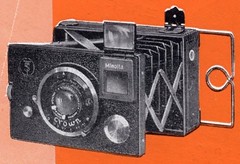
|
| Identical picture, with original Lidex marking or fake Crown marking. Scans by A. Apra. (Image rights) |
The advertisement in Toki no Nagare July 1935 shows a drawing of a camera with rectangular eyepiece.[12] Another leaflet dating c.1936 still lists the viewfinder Minolta along with the rangefinder version, but does not provide a picture.[13]
Actual examples
Very few actual examples of the original Minolta camera are known. The sequence of serial numbers might continue the Nifca sequence used on the Nifcarette and Nifca-Dox. The lowest number confirmed so far is 8796, on the example owned by the Pentax Gallery, which has a rounded eyepiece.[14] The serial number has an No. prefix, which seems to be specific of the earliest examples. The camera was modified at some time by adding a flash synch post and an accessory shoe. Its Compur shutter and Tessar 10.5cm f/4.5 lens are probably not original, as indicated by the Zeiss–Ikon nameplate attached to the shutter face.
At least two other cameras are known with the rounded viewfinder eyepiece and Lidex shutter (T, B, 1–200).[15] One of them is confirmed to have an Actiplan Anastigmat München 105mm f/4.5 lens in the 7xxxx range, and Patents(J.N.)–Pending at the top of the shutter plate.[16]
The example pictured in Minolta's 70th anniversary poster, perhaps from the company's own collection, has an Actiplan Anastigmat München 105mm f/4.5 lens and a rim-set Compur shutter (T, B, 1–250);[17] it is not known if this shutter option was commercially offered at some time or not. The body number is 8979, with the newer Nr. prefix, and the details of the eyepiece are unknown.
Later cameras have the rectangular eyepiece. At least one has been observed the Lidex and Actiplan Anastigmat München combination.[18]
Two further cameras are known with the Crown shutter (T, B, 1–200). Both have a rectangular eyepiece, and their exact lens name is unknown. The shutter plate has Patents(J.N.)–Pending on one example and Patents–Nippon on the other; the latter has a body number in the 10xxx range.[19]
Finally, one isolated camera is known with a Rulex shutter (5–200, B, T) by Neumann & Heilemann and an Actiplan Anastigmat München 105mm f/4.5 lens.[20] The only available picture does not show the viewfinder, and the camera might be an Auto Minolta instead. The Rulex has the older type of shutter plate (see Rulex). It seems unlikely that the Molta company bought Rulex shutters to Neumann and Heilemann, who brutally left the company in 1931–2, became direct competitors and were certainly not in good terms with Molta's founder Tashima Kazuo.[21] It is therefore probable that the mounting of a Rulex shutter was experimental, or the result of a repair.
Auto Minolta
 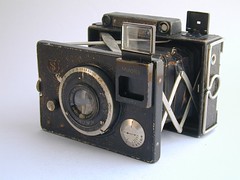
|

|

| |
| Autofocus Minolta no.9898, Crown shutter (T, B, 1–200), Actiplan Anastigmat Nippon 105mm f/4.5 lens no.89780. Pictures by eBayer hbpartner. (Image rights) | |

| |
| PATENTS–NIPPON behind the front plate. Picture by eBayer hbpartner. (Image rights) | |
The Autofocus Minolta (オートフォーカス・ミノルタ), later Auto Minolta (オート・ミノルタ), has a coupled rangefinder. It was released in 1935, and was the first Japanese camera equipped with such device.[22]
The rangefinder is contained in a casing placed above the camera, on the right of the viewfinder, with two round windows at the front. The internals consist of a fixed half-mirror and a rotating prism, and the base length is 7cm.[23] The eyepiece is at the left end, close to the viewfinder eyepiece. Four versions of this rangefinder casing are known. At least some examples of the Auto Minolta have a plate inscribed PATENTS–NIPPON screwed behind the front plate, next to the focusing wheel; it is not known if this was present on all the examples.
First version or "Autofocus Minolta"

|
| Autofocus Minolta in a leaflet dating c.1935. Scan by A. Apra. (Image rights) |

|
| (Image rights) |
The first version has a black leather-covered casing, with the name Minolta and the MTS logo of Molta inscribed on a small nameplate between the two rangefinder windows.
 
|
| Leaflet for the Autofocus Minolta dating c.1935. Scan by A. Apra. (Image rights) |
Early leaflets dating c.1935 have the name "Autofocus Minolta" instead of "Auto Minolta", but this name does not appear anywhere on the camera itself.[24] The camera is offered for ¥135 with six plate holders, a pack holder, a lens cap and a cable release. The pictures show the Crown shutter and Actiplan Anastigmat Nippon 105mm f/4.5 lens. The body number is 9192, retouched as 9392 in some pictures, the lens number is 84915, and the shutter has the Patents(J.N.)–Pending marking. The earliest dated advertisement is found in Asahi Camera April 1935; other advertisements dated June and July 1935 are similar, showing the same price of ¥135.[25] The advertisement in Ars Camera January 1936 uses the name "Auto Minolta", but still displays the first version.[26]
  
|
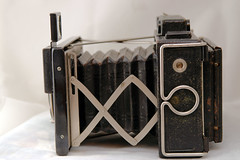  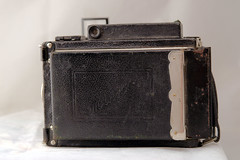
|
| Autofocus Minolta no.9964, Crown shutter (T, B, 1–200), Actiplan Anastigmat Nippon 105mm f/4.5 lens no.90867. Pictures by S. Montagna. (Image rights) |
Surviving examples of the first version are known with serial numbers in the 9xxx and 10xxx range. Most cameras, such as no.9898 and no.9964 pictured above, have the Actiplan Anastigmat Nippon 105mm f/4.5 lens in a Crown shutter (T, B, 1–200), inscribed Patents–Nippon.
 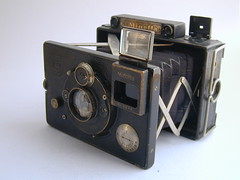
|
 
|

| |
| Autofocus Minolta no.9846, dial-set Compur shutter. Pictures by eBayer hbpartner. (Image rights) | |
 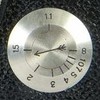
|
| Distance dial, down to 1m on no.9964, down to 1.1m on no.10237. (Image rights) |
One example (no.9846 pictured above) is known with a dial-set Compur shutter and a lens by Carl Zeiss; it is not known if this equipment is original or not. Another example (no.10237 pictured below) is known with the same Actiplan lens in a rim-set Compur shutter (T, B, 1–250). All the cameras have the close distance setting at 12 o'clock; the indication was switched from 1m to 1.1m at some time, around body no.10200.[27] (All subsequent models have 1.1m close focusing distance.)
  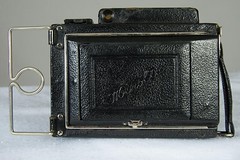
|
| Autofocus Minolta no.10237, Compur shutter (T, B, 1–250), Actiplan Anastigmat Nippon 105mm f/4.5 lens no.95023. Pictures by eBayer fap-ezonline.com. (Image rights) |
Second version or "Auto Minolta"

|
| (Image rights) |
The second version is very similar to the previous one but has the name Auto Minolta engraved on the nameplate and has no logo. This version appeared in winter or spring 1936, and is pictured in an advertisement dated July 1936.[28] A leaflet dating about the same offers the camera at the unchanged price of ¥135, along with the original Minolta at ¥97 and the ever-ready case at ¥4.[29]
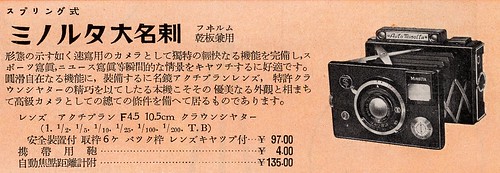
|
| Minolta and Auto Minolta in a leaflet for the Minolta and Happy range dating c.1936. Scan by A. Apra. (Image rights) |
The advertisement in Asahi Camera December 1936 uses the name "Autofocus Minolta" again, and offers three lens and shutter options:[30]
- Actiplan f/4.5 lens, Crown shutter (1–200), ¥135;
- Tessar f/4.5 lens by Carl Zeiss, Compur shutter, self-timer, ¥250;
- same lens, Compur-Rapid shutter, self-timer, ¥265.
The August 1937 advertisement in the same magazine shows the first and third options at an unchanged price; the Crown shutter is called "Crown A" and the Compur-Rapid is called "Compur RS" (presumably for Rapid Shutter). The January 1938 advertisement in Asahi Camera has the first option for ¥155 and the Tessar and Compur option for ¥295. (The sudden price rise might be related to new taxes levied after the outbreak of war with China.)[31] The price of the new versions with Tessar lens is very high, making them the most expensive Japanese cameras of the time (but for the Olympus Standard announced in 1937 at ¥275 but never produced in quantity).
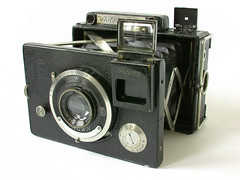 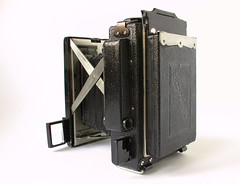
|
 
|
 
| |
| Auto Minolta no.11579, Crown shutter (T, B, 1–200), Actiplan Anastigmat Nippon 105mm f/4.5 lens no.100545. Pictures by A. Apra. (Image rights) | |
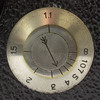 
|
| Distance dial: 1.1m at 12 o'clock on no.11579, at 10 o'clock on no.12186. (Image rights) |
Surviving examples of the second version are known with serial numbers in the 107xx and 12xxx range.[32] Most examples have the close distance setting at 12 o'clock, but at least two have a different distance scale with the closest setting at 10 o'clock; this feature seems independent of the lens or shutter type.[33]
Some cameras, such as no.11579 pictured above, have the Actiplan Anastigmat Nippon 105mm f/4.5 lens and Crown shutter (T, B, 1–200), inscribed Patents–Nippon. At least one example (no.11851 pictured below) is also known with the same lens and a rim-set Compur shutter (T, B, 1–250), a combination which is also found on the first version of the Auto Minolta (see above); it seems that this combination was never mentioned in advertising, but it was perhaps sold before the adoption of the Tessar lens.
 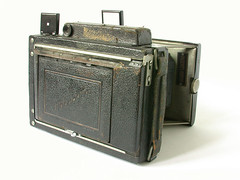 
|
| Auto Minolta no.11851, Compur shutter (T, B, 1–250), Actiplan Anastigmat Nippon 105mm f/4.5 lens no.100809. Pictures by A. Apra. (Image rights) |
The camera pictured below (no.12186) has the Tessar 10.5cm f/4.5 lens and Compur shutter (T, B, 1–250). Two examples are also known with a dial-set Compur shutter, including one whose front plate was heavily modified; it is not known if this equipment is original or not.[34]
  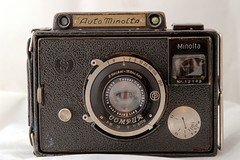
|
| Auto Minolta no.12186, Compur shutter (T, B, 1–250), Carl Zeiss Tessar 10.5cm f/4.5 lens no.1859293. Pictures by S. Montagna. (Image rights) |
Third version or "Auto Minolta New"

|
| Auto Minolta New in the July 1938 catalogue and price list by Asanuma Shōkai. Scans by A. Apra. (Image rights) |

|
| (Image rights) |
The third version has a larger rangefinder casing, with a slanted metal plate at the front, engraved Auto Minolta and including the holes for the rangefinder windows. The rest of the casing is usually leather covered, but it has an all-metal finish on at least one well known example (see below).
The third version is pictured in the July 1938 catalogue of Asanuma Shōkai.[35] In the corresponding price list, the camera is called "Auto Minolta New" (オートミノルタ新型), the shutter is called "Crown A" and the price is given as ¥155, including six plate holders, a pack holder and a lens cap.[36] Other accessories are listed as follows:
- hood and filter holder, 32×30mm, ¥1.70;
- portable leather case (携帯皮ケース), holding the whole set, ¥5;
- ever-ready case (速写ケース), for the camera alone, ¥7.50.
The last reported advertisement for the Auto Minolta appeared the same month of July 1938 in Asahi Camera.[37] However the official list of set prices compiled in October 1940 and published in January 1941 still has a "New Autofocus Minolta" (新型オートフォーカスミノルタ) for ¥310, in the same price category as the Auto Press Minolta. This does not necessarily mean that the camera was still produced at the time, and the price might apply to the remaining stocks only.
 
|
 
|
 
| |
| Auto Minolta no.12772, Crown shutter (T, B, 1–200), Actiplan Anastigmat Nippon 105mm f/4.5 lens no.101975. Pictures by A. Apra. (Image rights) | |
Surviving examples are known with serial numbers in the 12xxx range. All have the Actiplan Anastigmat Nippon lens and a Crown shutter, and all have the 1.1m closest distance setting at 12 o'clock. The shutter plate has a new design, with three metal stripes added on each side of the lens, no MTS logo, the words PATENTS–NIPPON in capital letters at the top, and the name CROWN inscribed on a larger aperture scale screwed to the bottom. (A similar design change occurred on the Semi Minolta around 1937, shortly before the release of the Semi Minolta II; the change probably occurred simultaneously on the Auto Minolta.) The only example known with an all-metal rangefinder casing has no.12744 and is pictured in various sources.[38]
Accessories
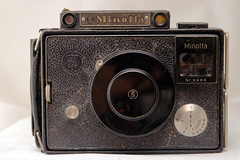
|
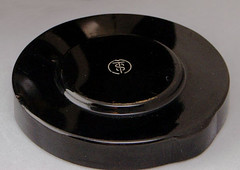
|
| Lens cap on the Autofocus Minolta. Pictures by S. Montagna. (Image rights) | |
The original cap for the Minolta and Auto Minolta is black with the MTS logo of Molta, and covers the whole shutter casing. It has a circular hump at the front to accommodate the lens, an indent on the side to leave space for the release lever and a small hump at the bottom for the aperture lever.

|

|
| Ever-ready case for the Auto Minolta. Picture by eBayer hbpartner. (Image rights) |
Auto Minolta with portable case. Picture by A. Apra. (Image rights) |
The original ever-ready case closely matches the camera's shape, and has a rectangular protrusion at the front for the lens and shutter unit. The "portable case" is larger and contains the camera with various plate holders. That pictured in this page has an Auto–Minolta embossing; the word TOKYO is inscribed on the lock, which has the same shape as on other cases for contemporary Minolta cameras, certainly supplied by the same subcontractor.

|
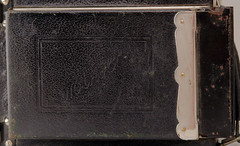
|
| Original ground glass back and film pack holder. Pictures by S. Montagna. (Image rights) | |
The ground glass back is identical to that of the Auto Press Minolta, except that the latch is nickel-plated instead of chrome-plated on the later model. The hood has a Minolta embossing, which is also found on the original film pack holder.
Notes
- ↑ The short user manual for the Minolta and Auto Minolta found in original leaflets, such as Minolta Camera 6.5×9cm, describes the operation of the shutter lock in the reverse direction, presumably because of a mistake in the documents: 手前に軽く引出せば安全装置がかかり、押せば安全装置が外れます.
- ↑ This model is sometimes called "Minolta I", for example in Francesch, p.75. This name does not appear in the original documents and was certainly crafted by collectors for easier identification.
- ↑ Supplied by Asahi Kōgaku: Lewis, p.182. The mention of a Coronar in McKeown, p.673, is a mistake.
- ↑ Some sources say that the Semi Minolta was released earlier but they are mistaken. See Semi Minolta (I) and II.
- ↑ Chronology: "Hensen kamera ichiran-pyō", p.295 of Shashin Kōgyō no.77 (September 1958), reproduced in this Flickr page by Rebollo_fr. Fifty-year history: Minolta 50-nen no ayumi, pp.5 and 65. In the latter, the release month was perhaps inferred from the date of publication of the "Minolta" trademark (see below).
- ↑ 1933: Francesch, pp.21 and 75, Scheibel, p.17, McKeown, p.673, Kamera no ayumi, p.61, Eimukku 735 Minolta, pp.131–2. — 1934: Awano, p.15 of Kurashikku Kamera Senka no.12, Lewis, p.48.
- ↑ Trademark publication (商標広告) no.S08-004434 for the name "MINOLTA" (ミノルタ) available in the IPDL trademark database.
- ↑ Leaflet Minoruta kamera izu.
- ↑ Leaflet Minolta Camera 6.5×9cm. The front cover is reproduced in Francesch, p.21, and in Scheibel, p.17.
- ↑ Leaflet Asanuma Shōkai hatsubai no kokusan kamera Minoruta Happī, reproduced in this page. The set includes six plate holders and a pack holder.
- ↑ Complete picture: Taniguchi, p.276 of Shashin Kōgyō no.77 (article also reproduced in Tanimura, p.8 of Camera Collectors' News no.116), Lewis, p.48, Kamera no ayumi, p.61. Cropped picture: Francesch, p.75, Scheibel, p.16, McKeown, p.673.
- ↑ Advertisement in Toki no Nagare July 1935, a publication of Asanuma Shōkai, reproduced in Tanimura, p.19 of Kurashikku Kamera Senka no.12.
- ↑ Leaflet Danzen kesshutsu shita kokusan kamera.
- ↑ Example pictured in Kamera no ayumi, p.58.
- ↑ Example pictured in Eimukku 735 Minolta, pp.131–2, and example pictured in Awano, p.15 of Kurashikku Kamera Senka no.12.
- ↑ Example pictured in Awano, p.15 of Kurashikku Kamera Senka no.12.
- ↑ Example pictured in the 70th anniversary Minolta poster, reproduced in this page at Photoclub Alpha. (The same picture is also copied in other websites.)
- ↑ Example observed in an online auction (body no.9251).
- ↑ Patents(J.N.)–Pending: example pictured in this page of the Center of the History of Japanese Industrial Technology. Patents–Nippon: example pictured in Awano, p.15 of Kurashikku Kamera Senka no.12.
- ↑ Lens and shutter unit pictured in Tanimura, p.97 of Kurashikku Kamera Senka no.12.
- ↑ In his autobiography, Tashima says that the sudden departure of the two Germans "was a shock so big you cannot tell": 私の受けたショックは言い表わされない程大きかった. (In Watakushi no rirekisho, quoted in Andō, p.2 of Camera Collectors' News no.127.)
- ↑ The date first appears in Taniguchi, p.277 of Shashin Kōgyō no.77, and in "Hensen kamera ichiran-pyō", p.295 of the same magazine (documents also reproduced in Tanimura, pp.7–8 of Camera Collectors' News no.116, and in this Flickr page by Rebollo_fr). The fifty-year history Minolta 50-nen no ayumi says August 1935 on pp.5 and 65 but an advertisement in Asahi Camera April 1935 is reproduced in Tanimura, p.11 of Camera Collectors' News no.118. The year 1935 repeated in Awano, p.15 of Kurashikku Kamera Senka no.12, Francesch, pp.22 and 78, Scheibel, p.21, Lewis, pp.52–3, Eimukku 735 Minolta, pp.131 and 133. Other sources give an earlier date, surely by mistake: Kamera no ayumi, p.58 (1934), Sugiyama, items 1195 (1933–4), McKeown, p.673 (1933), and Kikan Classic Camera 14, p.15 (1933).
- ↑ Fixed half-mirror and rotating prism: Noma, p.38. 7cm base length: leaflets Ōto-fōkasu Minoruta kamera and Asanuma Shōkai hatsubai no kokusan kamera Minoruta Happī.
- ↑ Leaflets Ōto-fōkasu Minoruta kamera and Asanuma Shōkai hatsubai no kokusan kamera Minoruta Happī.
- ↑ Advertisement in Asahi Camera April 1935 reproduced in Tanimura, p.11 of Camera Collectors' News no.118. Advertisement in Toki no Nagare July 1935 reproduced in Tanimura, p.19 of Kurashikku Kamera Senka no.12. Advertisement on the second cover of Nihon Shashin Kōgyō Tsūshin June 1st, 1935, reproduced on p.18 of Hyaku-gō goto jūkai no kiroku.
- ↑ Advertisement reproduced in Kokusan kamera no rekishi, p.96.
- ↑ Highest number with 1m: 10129; lowest number with 1.1m: 10237.
- ↑ Advertisement in Shashin Shinpō July 1936 reproduced in Hagiya, p.9 of Kurashikku Kamera Senka no.12.
- ↑ Leaflet Danzen kesshutsu shita kokusan kamera.
- ↑ Advertisement reproduced in Kokusan kamera no rekishi, p.96.
- ↑ See the 1937 section of the page on Japanese prices.
- ↑ s/n 10744 Photographica Collection Dirk Spennemann—with Rokuoh Sha Hexar in rim-set Compur. Patent Nippon and close setting (1.1 m) at 12 o'clock. The Hexar may be a replacement lens cell.
- ↑ Close setting at 10 o'clock: example pictured in the 70th anniversary poster, reproduced in this page at Photoclub Alpha and in other websites (Crown shutter, Actiplan lens), and example no.12186 pictured in this page (Compur shutter, Tessar lens).
- ↑ Example pictured in this page of Miyazawa Noriyuki's camera site, and heavily modified example pictured in this page at Kurokawa Shōten.
- ↑ July 1938 catalogue by Asanuma Shōkai, pp.4–5.
- ↑ July 1938 price list by Asanuma Shōkai, p.4.
- ↑ Kokusan kamera no rekishi, p.341.
- ↑ Auto Minolta no.12744 pictured in Francesch, p.78, Scheibel, p.20, McKeown, p.673, and Awano, p.15 of Kurashikku Kamera Senka no.12.
Bibliography
Original documents
- Asanuma Shōkai. Cameras — All other apparatus and materials — 1938. Catalogue dated July 1938, pp.4–5, and corresponding price list, p.4. Documents partly reproduced in this Flickr album by Rebollo_fr.
- "Kokusan shashinki no kōtei kakaku" (国産写真機の公定価格, Set prices of the Japanese cameras), listing Japanese camera production as of October 25, 1940 and setting the retail prices from December 10, 1940. Published in Asahi Camera January 1941 and reproduced in Shōwa 10—40nen kōkoku ni miru kokusan kamera no rekishi (昭和10〜40年広告にみる国産カメラの歴史, Japanese camera history as seen in advertisements, 1935—1965). Tokyo: Asahi Shinbunsha, 1994. ISBN 4-02-330312-7. Pp.108—9. Type 8, section 5.
- Leaflet for the Minolta, dated c.1933–4, by Asanuma Shōkai. Minoruta kamera izu (ミノルタ・カメラ出づ, The Minolta camera is released). Document owned by A. Apra and reproduced in this Flickr album by Rebollo_fr.
- Leaflet for the Minolta, dated c.1934–5, by Asanuma Shōkai. Minolta Camera 6.5×9cm. Document owned by A. Apra and reproduced in this Flickr album by Rebollo_fr.
- Leaflet for the Auto Minolta, dated c.1935, by Asanuma Shōkai. Ōto-fōkasu Minoruta kamera (オートフォーカスミノルタカメラ, Auto-focus Minolta camera). Document owned by A. Apra and reproduced in this Flickr album by Rebollo_fr.
- Leaflet for the Minolta and Happy range, dated c.1935. Asanuma Shōkai hatsubai no kokusan kamera Minoruta Happī (浅沼商会発売の国産カメラミノルタ・ハッピー, Japan-made Minolta and Happy cameras distributed by Asanuma Shōkai). Document owned by A. Apra and reproduced in this Flickr album by Rebollo_fr.
- Leaflet for the Minolta and Happy range, dated c.1936. Danzen kesshutsu shita kokusan kamera (断然傑出した国産カメラ, Definitely excellent Japan-made cameras). Document owned by A. Apra and reproduced in this Flickr album by Rebollo_fr.
- Nihon Shashin Kōgyō Tsūshin (日本写真興業通信). Hyaku-gō goto jūkai no kiroku (百号ごと十回の記録, Ten records, every hundred issues). Tokyo: Nihon Shashin Kōgyō Tsūshin Sha (日本写真興業通信社), 1967. No ISBN number. Advertisement on p.18, corresponding to the second cover of the June 1st, 1935 issue.
- Trademark publication for the name "MINOLTA" (ミノルタ). The trademark was applied for (商標出現) on 18 January 1933 (no.S08-000723), published (商標広告) on 1 June 1933 (no.S08-004434) and registered (商標登録) on 20 September 1933 (no.0246579). Available in the IPDL trademark database.
Official historical accounts
- Minolta Camera. Minolta 50-nen no ayumi (Minolta・50年のあゆみ, Minolta 50-year history). November 1978. Pp.5 and 65.
- Shashin Kōgyō no.77 (September 1958). "Hensen kamera ichiran-pyō" (変遷カメラ一らん表, Table of camera evolution.) P.295. (This is a chronology of Minolta cameras from the Nifcarette onwards. This document is reproduced in this Flickr page by Rebollo_fr.)
- Taniguchi Masao (谷口匡男), from the commercial department (営業部) of Chiyoda Kōgaku Seikō. "Minoruta kamera no sakujitsu, konnichi" (ミノルタ・カメラの昨日、今日, Minolta cameras, yesterday and today). In Shashin Kōgyō no.77 (September 1958). Pp.275–9. (The two first pages of this document, on pre-1937 cameras, are also reproduced in Tanimura, p.8 of Camera Collectors' News no.116.)
Recent sources
- Asahi Camera (アサヒカメラ) editorial staff. Shōwa 10–40nen kōkoku ni miru kokusan kamera no rekishi (昭和10–40年広告にみる国産カメラの歴史, Japanese camera history as seen in advertisements, 1935–1965). Tokyo: Asahi Shinbunsha, 1994. ISBN 4-02-330312-7. Item 270. (See also the advertisements for item 272.)
- Awano Mikio (粟野幹男). "Senzen no Minoruta kamera" (戦前のミノルタカメラ, "Prewar Minolta cameras"). Kamera Rebyū: Kurashikku Kamera Senka (カメラレビュー クラシックカメラ専科) / Camera Review: All about Historical Cameras no.12, October 1988. No ISBN number. Minoruta kamera no subete (ミノルタカメラのすべて, special issue on Minolta). Pp.13–7.
- Eimukku 735, Manyuaru Kamera Shirīzu 15 (エイムック735・マニュアルカメラシリーズ15). Minolta: Minoruta kamera no subete (Minolta:ミノルタカメラのすべて, Minolta: all of Minolta cameras). Tokyo: Ei Shuppansha, 2003. ISBN 4-87099-923-4. "Jabara-shiki kamera no kiseki" (蛇腹式カメラの軌跡", Evolution of folding cameras). Pp.131–3. Shows very small pictures and brief captions.
- Francesch, Dominique and Jean-Paul. Histoire de l'appareil photographique Minolta de 1929 à 1985. Paris: Dessain et Tolra, 1985. ISBN 2-249-27685-4. Pp.21–2, 75 and 78–9.
- Hagiya Takeshi (萩谷剛). "Kōkoku ni miru Minoruta kamera no rekishi" (広告に見るミノルタカメラの歴史, "Minolta camera history seen through the advertisements"). Kamera Rebyū: Kurashikku Kamera Senka (カメラレビュー クラシックカメラ専科) / Camera Review: All about Historical Cameras no.12, October 1988. No ISBN number. Minoruta kamera no subete (ミノルタカメラのすべて, special issue on Minolta). Pp.9–12.
- Kamera no ayumi. Zen nihon shashin renmei sōritsu 50-shūnen kinen (カメラのあゆみ・全日本写真連盟創立五〇周年記念, History of cameras, commemorating the 50th anniversary of the All Japan Association of Photographic Societies). Tokyo: Asahi Shinbunsha, 1976. No ISBN number. Pp.58 and 61.
- Kikan Classic Camera 14 Tokushū: Minoruta Rokkōru densetsu (季刊クラシックカメラ14・特集ミノルタロッコール伝説, special: Minolta Rokkor legend). Tokyo: Futabasha, 2002. ISBN 4-575-47427-4. Brief mention on p.15. (This special issue on Minolta mainly treats postwar SLR cameras, and has almost no information on the original Minolta and Auto Minolta.)
- Lewis, Gordon, ed. The History of the Japanese Camera. Rochester, N.Y.: George Eastman House, International Museum of Photography & Film, 1991. ISBN 0-935398-17-1 (paper), 0-935398-16-3 (hard). Pp.48 and 182.
- McKeown, James M. and Joan C. McKeown's Price Guide to Antique and Classic Cameras, 12th Edition, 2005-2006. USA, Centennial Photo Service, 2004. ISBN 0-931838-40-1 (hardcover). ISBN 0-931838-41-X (softcover). P.673.
- Noma Toshio (野間俊夫). Kyorikei-tsuki kamera no henpo (距離計付きカメラの変遷, Evolution of rangefinder cameras). Gendai Kamera Shinsho (現代カメラ新書) 65. Tokyo: Asahi Sonorama, 1979. No ISBN number. Pp.37–8.
- Scheibel, Anni Rita and Joseph. 70 Jahre Minolta Kameratechnik — Von der Nifcalette bis zur Dynax 9. Stuttgart: Lindemanns Verlag, 3rd edition, 1999. ISBN 3-89506-191-3. Pp.16–7 and 20–1.
- Sugiyama, Kōichi (杉山浩一); Naoi, Hiroaki (直井浩明); Bullock, John R. The Collector's Guide to Japanese Cameras. 国産カメラ図鑑 (Kokusan kamera zukan). Tokyo: Asahi Sonorama, 1985. ISBN 4-257-03187-5. Items 1195–7.
- Tanimura Yoshihiko (谷村吉彦). "Neumann & Heilemann: kieta ashiato, Minoruta setsuritsu to sono ato no karera wo otte" (Neumann & Heilemann 消えた足跡・ミノルタ設立とその後の彼等を追って, On the traces of Neumann & Heilemann at the founding of Minolta and afterwards.) Kamera Rebyū: Kurashikku Kamera Senka (カメラレビュー クラシックカメラ専科) / Camera Review: All about Historical Cameras no.12, October 1988. No ISBN number. Minoruta kamera no subete (ミノルタカメラのすべて, special issue on Minolta). Pp.96–9. (Contains a picture of a Rulex shutter mounted on a Minolta or Auto Minolta, and no other information on the strut folders.)
- Tanimura Yoshihiko (谷村吉彦). "Semi Minoruta I-gata to II-gata." (セミミノルタⅠ型とⅡ型, "Semi Minolta I and II") In Camera Collectors' News no.116 (February 1987). Nishinomiya: Camera Collectors News-sha. (Contains a reproduction of the articles in Shashin Kōgyō no.77, a discussion of the release dates and no other information on the strut folders.)
- Tanimura Yoshihiko (谷村吉彦). "Semi Minoruta I-gata to II-gata (sono 2)." (セミミノルタⅠ型とⅡ型(その2), "Semi Minolta I and II (part 2)") In Camera Collectors' News no.118 (April 1987). Nishinomiya: Camera Collectors News-sha. (Contains a reproduction of two advertisements showing the Auto Minolta, and no other information on the strut folders.)
- Tanimura Yoshihiko (谷村吉彦). "Supuringu kamera <Semi Minoruta>" (スプリングカメラ<セミミノルタ>, "'Semi Minolta' self-erecting camera"). Kamera Rebyū: Kurashikku Kamera Senka (カメラレビュー クラシックカメラ専科) / Camera Review: All about Historical Cameras no.12, October 1988. No ISBN number. Minoruta kamera no subete (ミノルタカメラのすべて, special issue on Minolta). Pp.19–24. (Contains a reproduction of an advertisement showing the Minolta and Auto Minolta, and no other information on the strut folders.)
Links
In English:
- Minolta and Auto Minolta in the 70th anniversary Minolta poster, reproduced at Photoclub Alpha
In Japanese:
- Minolta and Auto Minolta in the Camera database of the Center of the History of Japanese Industrial Technology
- Auto Minolta and more pictures in Miyazawa Noriyuki's camera site (the dial-set Compur shutter is perhaps not original)
- Auto Minolta (heavily repaired and modified) among past sales at Kurokawa Shōten
| Nifca, Molta and Chiyoda prewar and wartime cameras () | |
|---|---|
| folding plate cameras | |
| Nifcaklapp | Nifcasport | Sirius | Arcadia | Lomax | Eaton | Happy | |
| folding rollfilm cameras | telescopic bakelite cameras |
| Nifcarette | Sirius Bebe | Semi Minolta | Auto Semi Minolta | Minolta Vest | Baby Minolta | Minolta Six |
| strut-folding cameras | TLR cameras |
| Nifca-Dox | Minolta | Auto Minolta | Auto Press Minolta | Minoltaflex | Minoltaflex Automat | Minoltaflex military prototype |